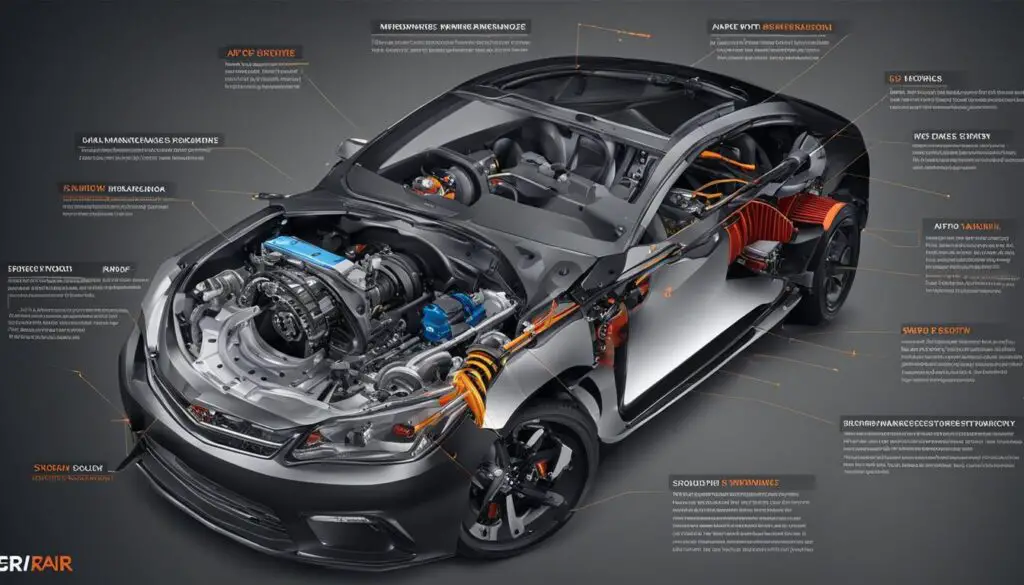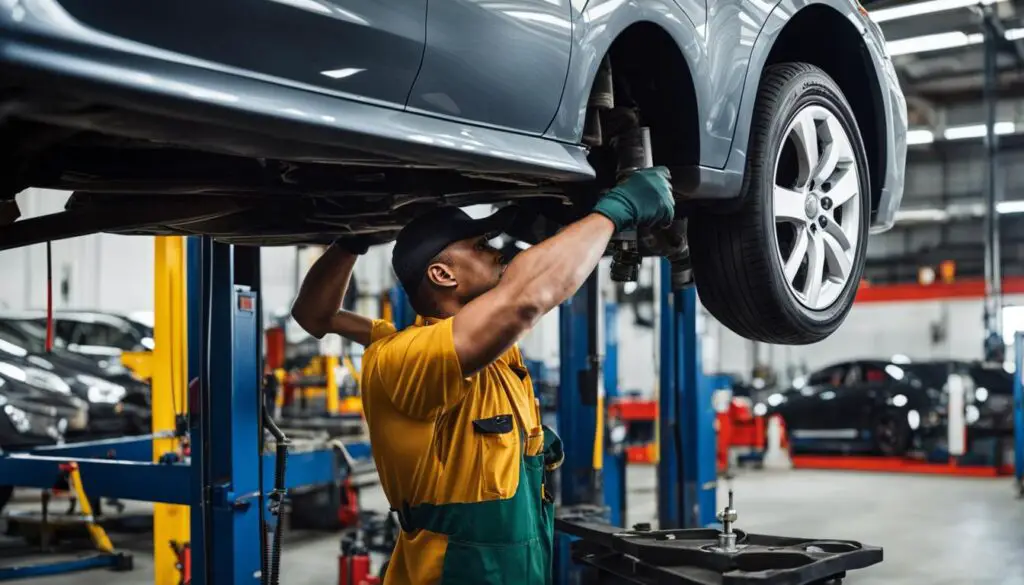
Understanding and Maintaining Your Car’s Suspension System
As a car owner, it is crucial to understand and maintain your vehicle’s suspension system. The suspension system is responsible for ensuring a smooth and comfortable ride, and proper maintenance can also extend the lifespan of your car. In this section, we will explore the key components of a car suspension system, common issues, and provide a comprehensive guide to ensure optimal performance and longevity.
Regular maintenance of your car’s suspension system is essential to avoid major repairs and ensure a safe driving experience. Neglecting suspension maintenance can lead to costly repairs and, in extreme cases, cause accidents. Therefore, it is crucial to prioritize the care of your suspension system.
Key Takeaways:
- Understanding your car’s suspension system is essential for a comfortable ride.
- Regular maintenance can extend the lifespan of your car.
- Neglecting suspension maintenance can lead to costly repairs and accidents.
- Proper maintenance includes regular inspections, alignment checks, tire rotations, and proper tire inflation.
- A comprehensive suspension system maintenance guide can help you prioritize care and avoid major repairs.
Key Components of a Car Suspension System
As mentioned in the previous section, the suspension system of a car plays a crucial role in ensuring a safe and comfortable ride. To maintain the system properly, it is important to understand its key components.
Shocks and Struts
Shocks and struts are essential components of the suspension system that help to control the movement of the springs. They work by absorbing the impact of bumps and uneven road surfaces to ensure a smooth ride. It is recommended to replace them every 50,000 to 75,000 miles to ensure optimal performance.
Springs
Springs are responsible for supporting the weight of the vehicle and providing a smooth ride. There are two main types of springs: coil springs and leaf springs. Coil springs are commonly used in modern cars, while leaf springs are used in heavy-duty vehicles. Regular inspections of the springs are necessary to avoid any damage or wear and tear.
Control Arms
Control arms are attached to the frame of the car and the steering knuckles. They serve as a link between the suspension system and the wheels, allowing for smooth movement and control. Regular inspection and replacement of control arms are essential to maintain the stability and control of the vehicle.
Other Components
Other essential components of a suspension system include ball joints, bushings, and sway bars. Ball joints connect the control arm to the steering knuckles, while bushings act as cushions between the suspension components. Sway bars, also known as stabilizer bars, help to improve stability and control during cornering and rough terrain. All these components must be inspected and maintained regularly to ensure optimal performance.
To keep your suspension system in top condition, follow this maintenance checklist:
- Inspect shocks and struts every 50,000 to 75,000 miles
- Regularly inspect and replace springs
- Check and replace control arms as necessary
- Inspect ball joints, bushings, and sway bars regularly
By following these tips and maintaining the key components of your car’s suspension system, you can ensure a smooth and safe ride for years to come.

Maintenance Tips for a Smooth Ride
Maintaining your car’s suspension system is crucial for a comfortable and safe driving experience. A well-maintained suspension system will provide better handling, improved tire wear, and a smoother ride. To ensure optimal performance, follow this maintenance schedule:
| Maintenance Task | Frequency |
|---|---|
| Inspection of suspension system | Every 6 months |
| Alignment check | Every 6 months or as needed |
| Tire rotation | Every 6,000 – 8,000 miles or as recommended by the manufacturer |
| Tire pressure check | Monthly or before long trips |
Note: It is important to consult your car’s owner manual for specific maintenance recommendations.
In addition to the maintenance schedule, here are some tips for maintaining your car’s suspension system:
Tip 1: Listen to Your Car
Pay attention to any unusual sounds, such as knocking, squeaking, or clunking coming from your suspension system. If you hear any of these sounds, it may indicate that a component is damaged or worn and needs to be replaced.

Tip 2: Check for Uneven Wear
Uneven tire wear can be a sign of suspension problems. Check your tires regularly for uneven wear and have your suspension system inspected if you notice any issues.
Tip 3: Avoid Potholes and Rough Roads
Driving on rough roads and hitting potholes can cause damage to your suspension system over time. Avoid potholes and drive slowly on rough roads to minimize wear and tear on your suspension.
Tip 4: Replace Your Shocks and Struts
Shocks and struts play a crucial role in your suspension system and can wear out over time. Replace them as recommended by the manufacturer to ensure optimal performance.
By following these suspension system maintenance tips and guidelines, you can ensure a smooth and comfortable ride for your vehicle. Regular inspections, alignment checks, tire rotations, and proper tire inflation are essential maintenance practices to maximize the lifespan of your suspension system.
Conclusion
In conclusion, I cannot overstate the importance of maintaining your car’s suspension system. It plays a vital role in providing a smooth and safe driving experience. By following the tips and guidelines provided in this article, you can ensure optimal performance, longevity, and peace of mind.
Regular maintenance is essential to maximizing the lifespan of your suspension system. Make sure to follow the recommended maintenance schedule, including regular inspections, alignment checks, and tire rotations. Proper tire inflation is also crucial for optimal performance and a smooth ride.
Remember, neglecting your car’s suspension system can lead to costly repairs and even dangerous driving conditions. Maintaining your car’s suspension system should be a top priority for all car owners. Don’t wait until it’s too late to take care of your car’s suspension system. Start implementing maintenance best practices today.
In conclusion, maintaining your car’s suspension system is crucial for a safe, comfortable, and long-lasting driving experience. By keeping up with regular maintenance and following the guidelines laid out in this article, you can ensure that your car’s suspension system is always performing at its best.
FAQ
What is the purpose of a car’s suspension system?
The suspension system in a car is responsible for providing a smooth ride, maintaining traction, and ensuring vehicle stability. It helps absorb shocks and vibrations from the road, allowing the tires to maintain contact with the surface and providing comfort to passengers.
How often should I inspect my car’s suspension system?
It is recommended to have your suspension system inspected at least once a year or every 12,000 miles. However, if you notice any signs of issues such as uneven tire wear, bouncing or swaying while driving, or difficulty steering, it is advisable to have it checked sooner.
What are common signs of suspension system problems?
Common signs of suspension problems include uneven tire wear, excessive bouncing or swaying, a rough or uncomfortable ride, difficulty steering, and a nose-diving sensation when braking. If you experience any of these issues, it is advisable to have your suspension system inspected by a professional.
Can I perform suspension system maintenance myself?
While some maintenance tasks can be performed by car owners, such as checking tire pressure or visual inspections for signs of damage, it is recommended to have a professional technician handle more complex suspension system maintenance, such as replacing worn-out components or performing alignment adjustments.
How can I prolong the lifespan of my car’s suspension system?
To prolong the lifespan of your car’s suspension system, it is essential to follow regular maintenance practices. This includes regular inspections, proper tire inflation, regular wheel alignments, avoiding driving over potholes or uneven surfaces whenever possible, and addressing any issues promptly to prevent further damage.
How do I know if my shocks or struts need to be replaced?
If your car’s shocks or struts are worn out, you may notice excessive bouncing, a rough or uncomfortable ride, longer stopping distances, or uneven tire wear. If you suspect that your shocks or struts are worn out, it is best to have them inspected by a professional technician who can determine if replacement is necessary.
